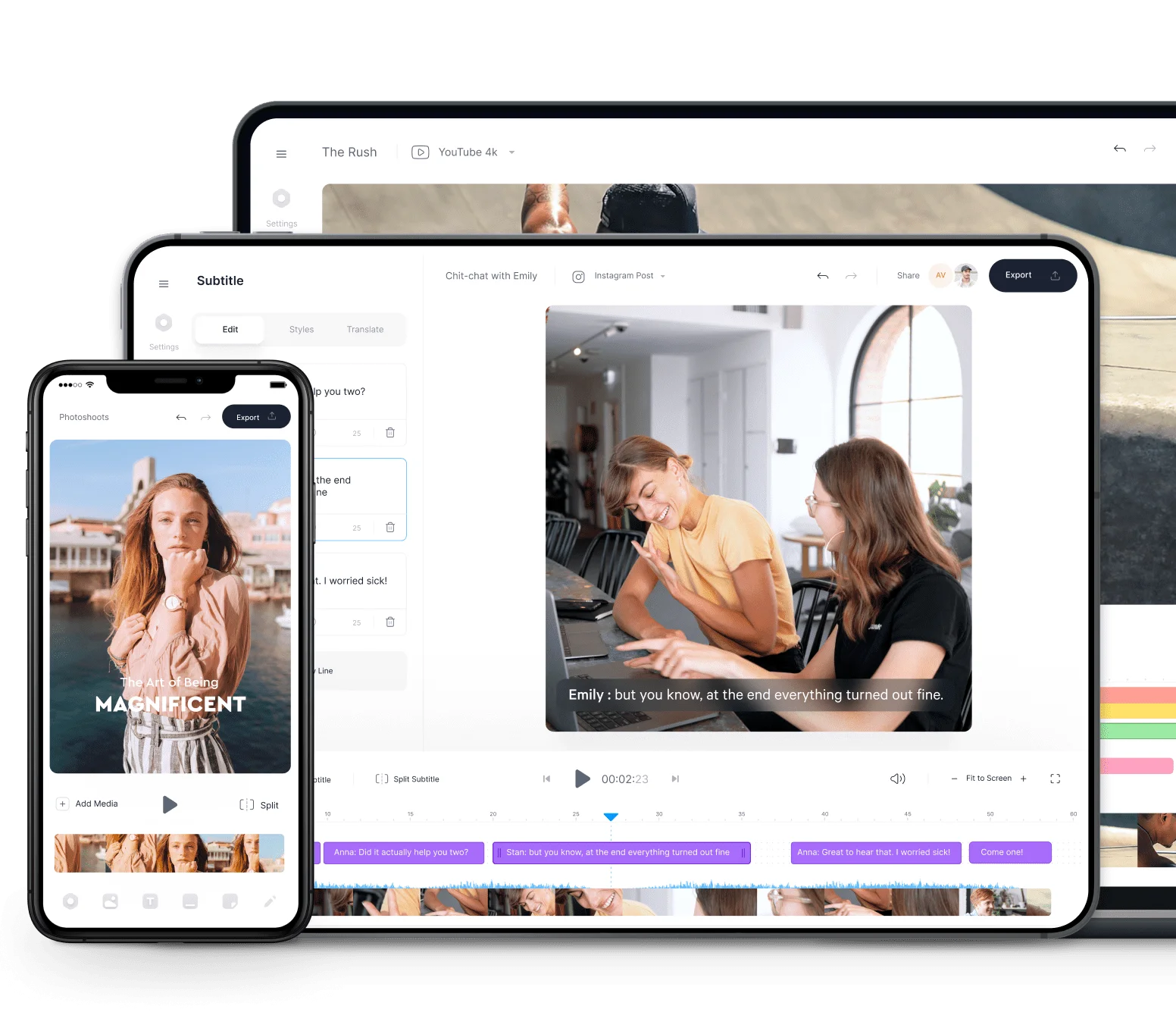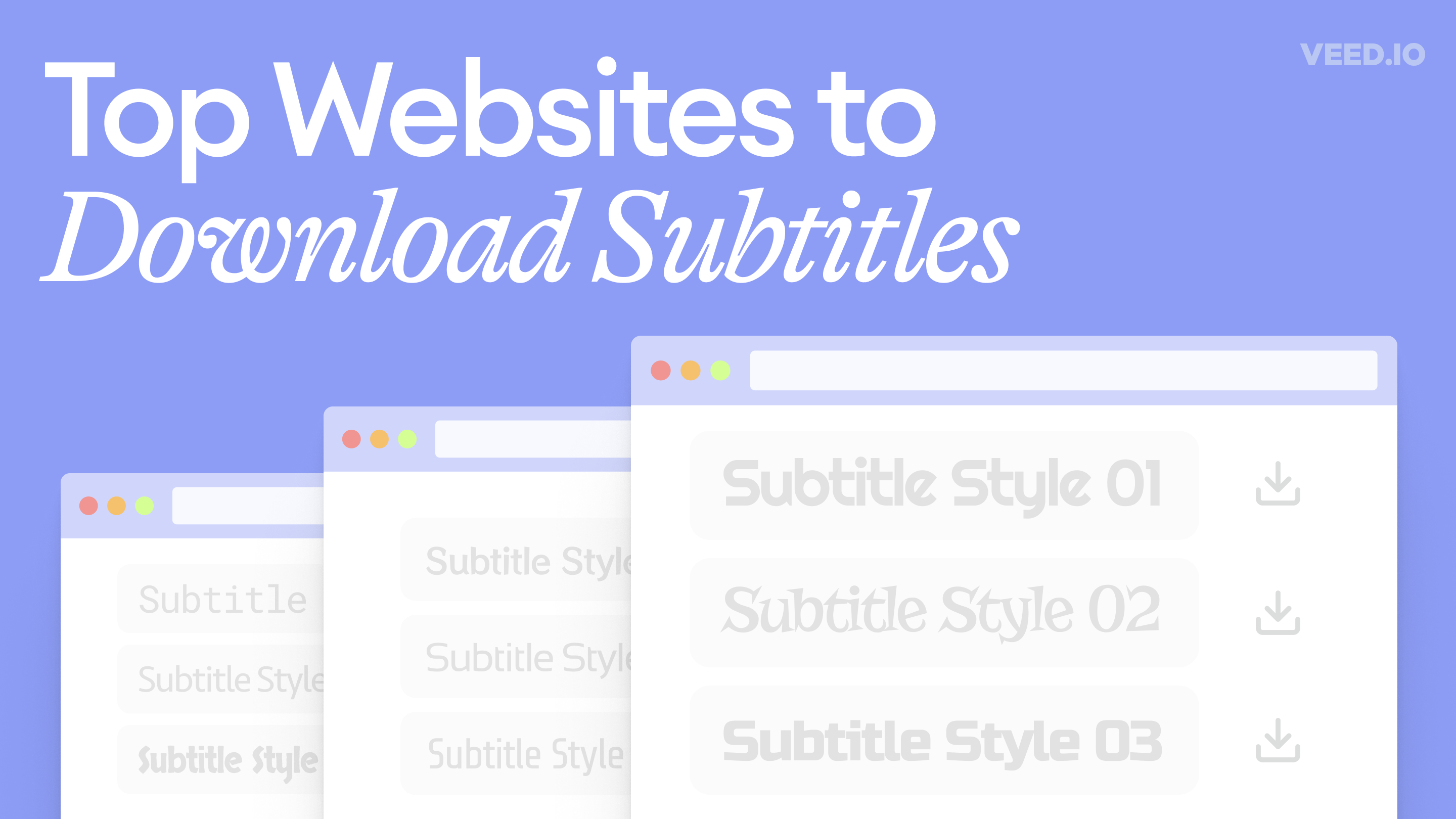Is there a distinction between closed captioning vs subtitles? The short answer is, yes.
Several film fans have been guilty of confusing the two, failing to notice some of the more subtle differences. Yet, in the current media environment, any social media video creator or prospective filmmaker should be able to tell the two apart, knowing which to use and when.
If you’d like to understand what differentiates subtitles and closed captioning, or how to add them to your own videos with ease, then this is the article for you. In no time at all, you’ll be correcting all your film fanatic friends when they use the terms interchangeably, and making all your future videos a lot more accessible to a global audience.
What are Subtitles?
If you have ever watched a foreign film or struggled to decode a characters’ accent, you’re probably familiar with subtitles. They are live transcriptions or translations of the dialogue between characters, usually presented at the bottom of the screen at the time at which they are spoken. This allows the audience to quickly refer to them when a line of conversation, or an entire language, escapes their understanding.
As an increasing amount of cinema and television moves to a more digital medium, the use of subtitles has become more widespread and more essential than ever before. Subtitles mean more languages, broader audiences and the capacity for recognition across the world. Almost every major video streaming platform aims to enable their use, ideally in a wide variety of languages. To exclude them from your content would be to limit your reach.

By breaking the barriers between languages, subtitles have caused a rise in the consumption of internationally produced content. Even in countries that create so much media of their own, foreign movies and tv shows have captured the audience's attention and forced their way into popular culture.
A vast number of people have even begun to use foreign films as a resource for learning foreign languages. Research demonstrates that they can help enhance your vocabulary and improve your comprehension. Subtitles have always been a tool for understanding. What’s increased is the willingness of consumers to rely on them.
VEED's Auto-Subtitle feature allows creators to bring subtitles to all of their content with ease. It automatically generates subtitles for your videos and then renders them into the video permanently (hardcode subtitles), or downloads them as a separate subtitle file (SRT, VTT, TXT, etc.) Using artificial intelligence, our subtitle generator offers near-perfect accuracy combined with a simple, user-friendly editing experience.
If your next video needs subtitles, which it probably does, now you know exactly where to go.
Closed Captioning vs Subtitles: What are the differences?
What is Closed Captioning?
Captions can be divided into two categories: open and closed. Open captions cannot be turned off as they are embedded in the video. On the other hand, closed captions allow the viewer to switch it on and off, much like subtitles can. This is probably why most people are unaware of the difference between the two.
Difference between Closed Captioning and Subtitles
The difference between closed captioning and subtitles is that while subtitles are intended for those who cannot understand the dialogue, closed captions are intended for times when the entire audio component can’t be heard by the viewer.

Unlike subtitles, however, captions translate all the words and sound into text such as background sounds, speaker distinction and any other information that the audio would have communicated. Subtitles, on the other hand, assume that the audience can hear the audio, but cannot understand the dialogue. Therefore, they don’t need to include any background noises or point out which character is speaking, because this will be evident in the audio itself.
The other difference between subtitles and closed captions is that subtitles are usually developed before the release of the video in question. They are transcribed in time with the audio and saved accordingly. Captions, however, can be broadcasted live on television and are often being typed out and encoded as a show is being aired. In some cases, captions might even be placed in a different position on the screen, to prevent any obstruction. Subtitles, having been produced beforehand, cannot be moved in this way.
Closed captions, while useful, can also be divisive. Some viewers reportedly find them distracting and obstructive to their entertainment. Even though studies suggest that a continued use of closed captioning will not only make your brain accustomed to them but will also improve your literacy rate, there are those who just can’t get used to them.
Despite what some opinions might suggest, research indicates that Gen Z is more inclined to use closed captioning than any generation before them. For individuals with disabilities including Autism and ADHD, closed captions can improve both their focus and their retention of information. People with no disability also found them beneficial to their learning, with a majority opting to use them regularly.
By offering the option to be switched on or off at will, closed captioning can keep all your viewers happy. By including them in your videos, you provide an inclusive experience that will be appreciated by many members of your audience, especially people struggling with hearing, ADHD, Autism etc.
For anyone who prefers their videos caption-free, they have the freedom to get rid of them with the simple push of a button.
What are SDH subtitles (subtitles for the deaf and hard of hearing)?
Subtitles for the deaf and hard of hearing, or SDH are subtitles in the language being spoken that include sound effects, speaker identification and other information conveyed via audio. They essentially play the same role as closed captioning, on mediums where closed captions are unavailable.
The additional information included in both SDH and closed captions is extremely essential for anyone who suffers from a hearing inability. It offers a complete understanding of all the sound elements, giving them as complete an experience as possible. In the U.S. all public television is obligated to include closed captioning, in accordance with the Americans with Disabilities Act (ADA.) For all platforms on which closed captioning is not an available option, SDH goes a long way in ensuring inclusivity and accessibility for all.
How to Add Subtitles to Video
As a video creator or filmmaker, adding subtitles to your work can have a whole range of benefits. They can help you as much as they help your audience, especially when your videos are being shared digitally.
The most obvious reason to subtitle your work is to enable broader accessibility. It opens up your work to audiences facing language barriers and hearing difficulties, considerably widening your platform. This in turn can boost your engagement.
Subtitles have been proven to increase viewer retention and ensure that there are no lapses in understanding. More than 80% of the videos consumed on mobile are watched without audio. With subtitles, your videos can be consumed on the go, and the message will always be communicated.

Not only can you improve the SEO of your website but you can also improve the SEO of your videos! Adding an SRT subtitle file to your video can also have SEO benefits, particularly on Youtube. Your videos will become easier to find in a related search, gaining more attention and more views. Subtitles have become an essential to modern content consumption. The audience depends on them more than ever before.
VEED aims to make adding subtitles to your videos so easy that it would be stupid not to use them. As a leading digital video-editing platform, we offer a range of features that help our users enhance and upgrade their content, even if they have minimal editing experience.
With our AI-based automatic subtitle generation, all it takes is the click of a button and your entire video can be subtitled to perfection. Much like the rest of our platform, all our subtitle features are designed for convenience and practicality.
To add subtitles to any video, here is what you do:
1. Upload video to VEED.IO
We offer the option to upload videos from anywhere, be it your phone, computer, dropbox or even a Youtube URL. Don’t waste your time transferring files between devices. Get uploading and get started!

2. Click on Subtitles Tab and then Auto Transcribe
The auto-transcribe feature generates subtitles for your entire video, with near perfect results. We do also offer you the option to type them out manually or upload them from a subtitle file (eg. SRT, VTT, ASS, SSA, TXT)

3. Check your Subtitles
Whichever option you choose, you can then check your subtitles for any possible errors. We enable easy editing, be it for the timing, the color, the font, the size or the text itself.

4. Customize your video (Optional)
Our features go well beyond simple transcription. We offer subtitle translation, to help you broaden your audience even further. You can also make further edits to your video by adding music and audio visualizers, adding filters, video effects, and more.

5. Export and download your video
Once you’re satisfied with your subtitles and all your other effects, you can export your video and get ready to share your work with the world. If your goal is to upload your content to social media, we can help you further optimise it to the settings of major social platforms. Our video compression settings keep you from running into trouble while uploading, by making sure that the format lines up precisely with your needs. We even give you the option to download your video as a GIF, for some quick and shareable content.

Recap of When To Use Subtitles and Closed Captions
To quickly sum up the differences and uses of subtitles and closed captions,
Subtitles are used if:
- The audio needs to be translated into another language.
- Non-speech elements (sound effects, speaker differentiation etc.) are not required.
- The text needs to be synchronized with the media before-hand.
Closed-Captions are used if:
- Speakers need to be identified.
- Sound effects and other non-speech audio must be included.
- The text can be transcribed live, as the video is being aired.
- You are being inclusive of hearing impairments that audience members may face.
If you want to create videos for the broadest possible audience in the current digital environment, subtitles are a necessity. VEED makes the transcription and translation of your dialogue easier than you could ever have imagined. Try VEED for free and start making your content professional, accessible and easy for your audience to engage with. Once you try our auto-subtitle generator, you’ll never do your subtitles any other way again.






![75+ Captions for Instagram [For Every Mood, Vibe, and Occasion]](https://assets-global.website-files.com/616e938268c8f0a92cb2b540/65ad5248623eef32c39a7e0d_Hero%20(1)-min.png)
/Add-Subtitles-to-Video.png)
/Video%20Editor.png)